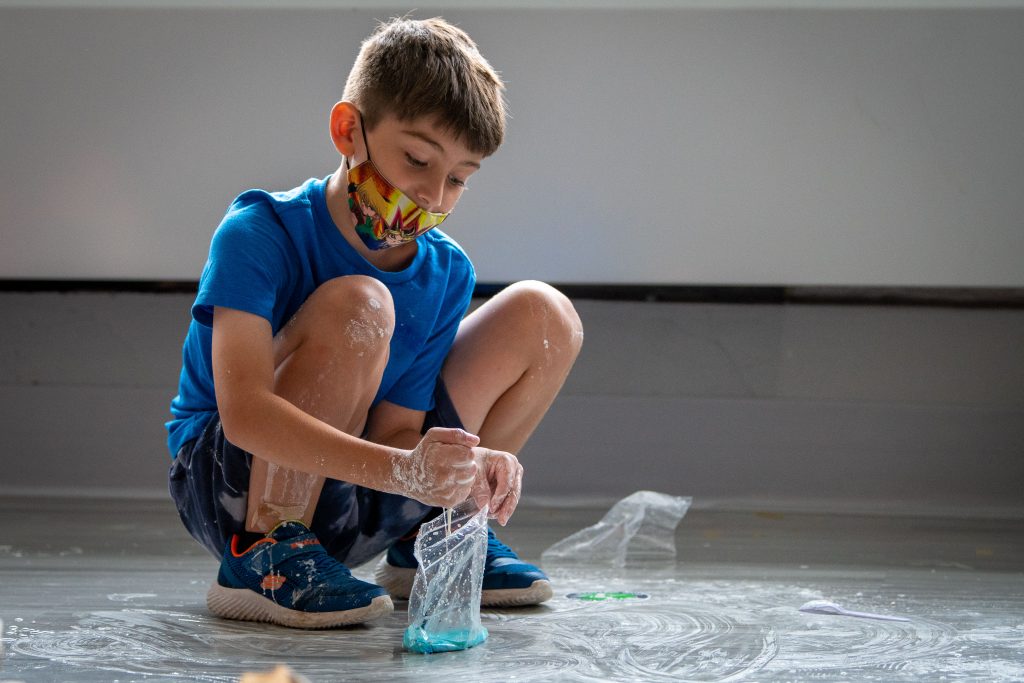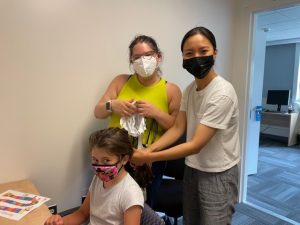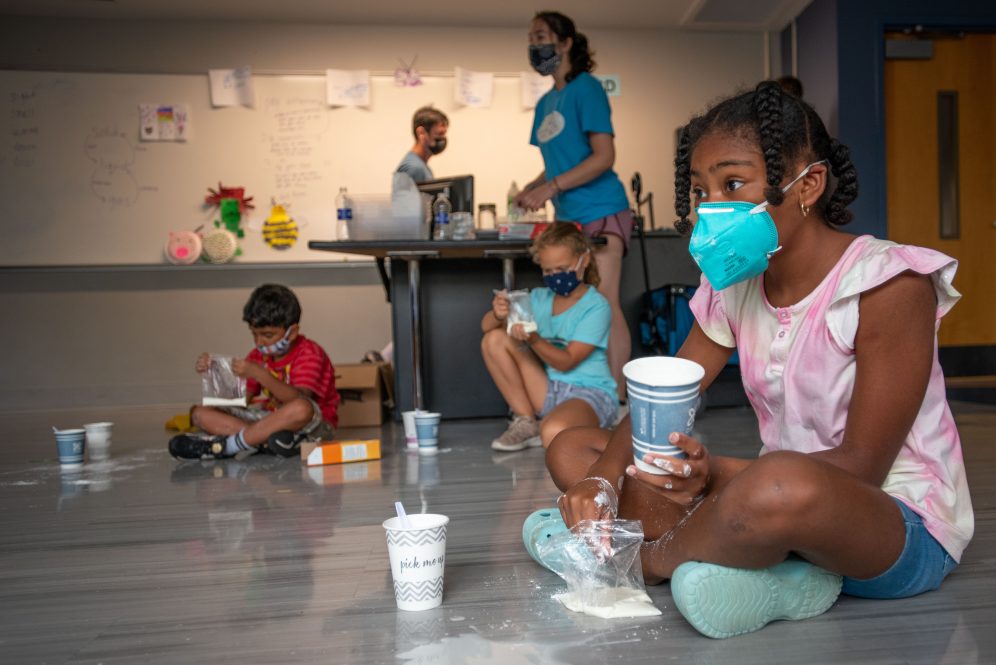On a recent cloudy day at Storrs, shouts of joy, confusion, and laughter could be heard in the Henry Ruthven Monteith building by Mirror Lake as a group of children tried to mix corn starch and water to the perfect ratio. The goal was to make oobleck, a pressure-dependent substance that changes from liquid to solid at the touch.
Meanwhile, behind the neighboring Jaime Homero Arjona building, another group of children added vinegar to dish soap in a plastic cup and, delighted, shrieked as it erupted like a volcano.
“I like it – we always get to play and learn new things and make friends,” said Logan, a B.R.A.I.N. camp participant from Coventry.
Logan and his friends are participating in UConn’s B.R.A.I.N. Camp, also called Bridging Reading And Intervention with Neuroscience Camp, where experiments like these join with daily reading and math exercises and weekly EEG scans.
This summer, UConn neuroscientist Fumiko Hoeft, Associate Professor of Educational Psychology Devin Kearns, and collaborators from Psychological Sciences, the Neag School of Education, Mathematics, Brain Imaging Research Center (BIRC), and others launched the five-week, all-expenses-included summer camp at Storrs for 3rd and 4th grade children who are struggling to read.

“When it comes to teaching children with learning disabilities, early intervention is key to academic outcome, self-esteem, and life success,” says Hoeft, professor of psychological sciences and Director of BIRC.
“There is great evidence that certain reading interventions work, but they do not work for everyone,” Hoeft says. Up to 30% of children who struggle to read (often known as children with dyslexia) might continue to struggle to read as they get older, she says.
“This is why we want to provide early intervention and add new pieces to these interventions that we think will work based on science, and on the child’s learning profile. If we can make this work, it is a great step toward personalized learning,” says Hoeft.
As a neuroscientist whose research explores biomarkers of learning disabilities such as dyslexia—patterns of brain structure and function or chemistry that would predict who responds to what kind of interventions—Hoeft is familiar with early signs of reading difficulties in children.
For instance, if a child does not know letters or letter sounds, those are risk factors in becoming dyslexic. But typically, dyslexia cannot be diagnosed until a child is a couple of years behind in reading.
“For each year we delay providing evidence-based interventions, say from pre-K to Kindergarten, Kindergarten to 1st grade and so on, the effectiveness goes down by 25-50% each year,” says Hoeft.
With funding from the Oak Foundation, Hoeft, the PI of the project, and co-PI Devin Kearns, along with post docs Lam and Lau, set up three research based reading interventions and one research based math intervention that were taught by experienced instructors during academic blocks at camp.
The interventions track the students’ improvement by assessing behavior and cognition and with brain imaging techniques, functional MRI (fMRI) and weekly electroencephalography (EEG). This way, the researchers can find a complex set of markers that predict intervention response, and sensitively track how they change in terms of brain and behavior.

“With the EEG cap on their head, we do a couple of tasks,” says Ashley Parker, a doctoral student in Speech, Language and Hearing Sciences who is the EEG specialist at B.R.A.I.N. Camp working under the lead EEG researcher and postdoc, Silvia Clement Lam.
One task asks the students to read many words that flash on a computer screen, and have them press a button when they see the same word twice. Another task has them read nonsensical sentences, such as “It is snowing, so let’s go outside and build Grandpa.”
In addition to three types of reading interventions, a math intervention acts as the control intervention.
“Math is also intricately related to reading, and there are theories that suggest that some types of math activities may even help those with reading problems,” says Hoeft.
Parker, together with other graduate students, undergraduate students, and even high school interns, will analyze the campers’ brain waves as they read, and collect data over the five weeks of camp to track their progress.
“I’ve noticed them just start laughing as they read these sentences,” Parker says. “Even in just a week they’ve come such a long way on their reading progress.”
A recent grant from the College of Liberal Arts and Sciences (CLAS) to multidisciplinary collaborators (including Hoeft, mathematics professor Fabiana Cardetti, and post-docoral researchers Lam and Airey Lau) enabled Hoeft and her team to recruit students from diverse backgrounds and provide lunch, snacks, and a school bus to shuttle students from Hartford to Storrs.
“Thanks to CLAS, the diversity of students is quite remarkable, and unique for this type of intense neuroscience research,” Hoeft says. “Typically, these neuroimaging projects skew toward mid- and higher-income families, so we get a skewed sample, but we wanted to get a more representative population. Hardly anyone has studied diverse students with reading disabilities.”
The project also includes a socio-emotional focus, exploring how learning disabilities affect lifelong mental health.
Research shows that rates of anxiety and depression are two to five times more prevalent in children with learning disabilities, says Hoeft, in addition to a higher rate of ADHD, suicide, and incarceration rates in adults.
“The hope is that by providing early interventions, the kids will never have to feel low self-esteem,” Hoeft says. “We hope that by giving them early, intense, and theoretically-motivated interventions at camp, they won’t have to struggle for years and become more socially-emotionally challenged.”
B.R.A.I.N. Camp is a collaborative effort that has been in the works for over two years. In addition to Co-Directors Fumiko Hoeft and Devin Kearns, the team includes: Research assistants Nina Bayer and Sumita Saluja from the Neag School; post-doctoral researchers Silvia Clement-Lam and Airey Lau from psychological sciences; mathematics professor Fabian Cardetti and psychological sciences professor Jim Magnuson; and graduate students including Yi Wei, Ashley Parker, Michael Urbanski.



